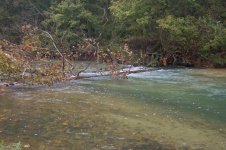Bill W. will recall a well-pinned canoe he helped extract from under a strainer on the Buffalo River a couple of years ago. Not his boat or mine but a member of our group.
Wasn’t Willie’s canoe pinned atop that boat in that same strainer?
Throw bags and rescue ropes are your friend, even on seemingly benign swamp trips.
A tale on that throw bag topic. I now bring a throw rope on every trip, even on solo trips where I can’t very well throw it to myself. The few (fortunately I can count on two fingers) times I wished I had a throw rope and didn’t outweigh that minor inconvenience.
I was the Master of Ceremonies at a Canoe Orienteering Contest. Hand painted scrap wood “Duckheads” on stakes, hidden in the Marsh, denoted on a hand-out map with compass headings from a piece of surveyor’s tape at the water’s edge. As part of the set up crew I was ineligible to participate.
Side note – The set up was at least as much fun as participating in the hunt, maybe more as the production crew got more and more devious as the years went on. To wit:
“OK, #17 is 87 feet NNW of this surveyor’s ribbon marked on the edge of the marsh” Except that 87 feet NNW is measured across the water to the other side of the gut, and you landed on the wrong side before looking at the compass dummy.
“OK, this one should be easy, #20 is only 15 feet from the tape”. Except the flag tape is in the middle of a 200 yard long bank of pluff mud (we landed 100 yards away and salt marsh cordgrass hummock jumped over from there to place the marker).
Friend Vic landed directly at the flag on one such challenge, turtle swam spread eagle across the pluff mud surface in a wet suit and reached a marsh grass hummock only to turn and see that his orienteering map had fallen out 30’ from shore, resting smearily atop the pluff mud. Er, yer gonna need that map Vic, best flail back across to recover it before trying for the marker.
We held that Canoe Orienteering contest in the Fishing Bay Wildlife Management Area, a salt marsh with no end of guts and sloughs and back marsh lakes.
https://www.google.com/maps/place/F...df28f732edacd05!8m2!3d38.3312586!4d-75.931808
Friend Chip brought a spry bowman (lady) one year, an experienced Tough Mudder participant.
https://toughmudder.com/
Their sneaky plan was that Chip would put Tough Mudder Lady ashore on one side of the circuit, and she run a few miles across the marsh collecting tokens while Chip paddled the perimeter, capturing what he could on the outside rim.
Maybe not the best plan. Mudder Lady ended up on the far side of the river, after having swum across the serpentine river channel and assorted wide guts multiple times, not quite sure where she was, with no Chip in sight.
Where was I in Canoe Orienteering tales? Oh, throw bags. A newbie threesome showed up one year with an ancient and ill-kept Old Town Berrigan. They had crudely set it as a 3-person boat, with a third seat attached in the center cargo area.
It looked to me like an entrapment capsize disaster waiting to happen. I had brought a couple of spare loaner canoes, just in case, and put them in what I had left on the van, a Penobscot 16.
Not the best choice. They paddled 30 feet out into the river, performed a completely wrong-in-every-way pivot in the tidal current while I watched, and all instantly swam.
Dammit, I’m not even paddling. My task is just standing onshore waiting to welcome the contestants back, what the heck would I need a throw rope for?
It was a holy mess getting them and (my) boat to shore, and I really could have used a throw rope. Since then I bring a throw rope on every trip.
Beyond that each of our vehicles has a stuff bag with an old PFD, a throw bag (some DIY’ed), some spare rope and straps, and etc. Those stuff bags are the size of a shoe box - OK, a boot box – but I spend a lot of time around paddle-able waters, and it is a comfort knowing I have that stuff available in each vehicle.
That old PFD, throw bag, rope and straps have come in handy a time or three. Especially the throw bag; I would really like all of my companions to have a throw bag in their canoe. To throw to me, dammit!
BTW, that silly Canoe Orienteering Contest was the most laughs we ever had as a group of paddling friends, First, Second and Third Place finisher awards, Muddiest Canoe Award, Last Place Award (a new compass). We did not have Participation Trophies, but we really should have.
I
highly recommend setting up a devious Canoe Orienteering course if you have a half dozen or more paddling friends or belong to a paddling club. It will absolutely serve to heighten the participant’s map and compass skills, and their situational awareness, if not their level of trust in the devious set up crew.
..

